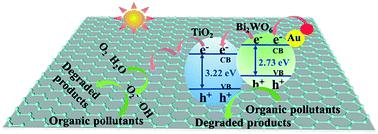当前位置:
X-MOL 学术
›
Environ. Sci.: Nano
›
论文详情
Our official English website, www.x-mol.net, welcomes your
feedback! (Note: you will need to create a separate account there.)
3D heterogeneous CTF@TiO2/Bi2WO6/Au hybrid supported by hollow carbon tubes and its efficient photocatalytic performance in the UV-vis range
Environmental Science: Nano ( IF 5.8 ) Pub Date : 2020-05-12 , DOI: 10.1039/d0en00307g Aiqin Gao 1, 2, 3, 4, 5 , Ju Wang 1, 2, 3, 4, 5 , Huanghuang Chen 3, 6, 7, 8 , Aiqin Hou 3, 6, 7, 8 , Kongliang Xie 1, 2, 3, 4, 5
Environmental Science: Nano ( IF 5.8 ) Pub Date : 2020-05-12 , DOI: 10.1039/d0en00307g Aiqin Gao 1, 2, 3, 4, 5 , Ju Wang 1, 2, 3, 4, 5 , Huanghuang Chen 3, 6, 7, 8 , Aiqin Hou 3, 6, 7, 8 , Kongliang Xie 1, 2, 3, 4, 5
Affiliation

|
Tunable hollow 3D nanostructured materials have attractive photochemical properties and their development is important for improving environmental waste treatment. In this work, a multicomponent 3D heterogeneous CTF@TiO2/Bi2WO6/Au hybrid was prepared and characterized. Calotropis gigantea fiber, a natural biopolymer with a unique hollow structure, was used as a template and carbon source. Gold nanoparticles and Bi2WO6 were assembled on the surface of nano-TiO2, which was supported by the 3D hollow carbon tube fiber (CTF). Benefitting from the controlled assembly of nano-sized Bi2WO6 and Au on the CTF, the UV-visible absorption over the entire visible range from 400 to 800 nm was greatly improved. The 3D structure improved the separation of electrons and holes. The UV-vis light decomposition of a series of organic wastewater pollutants, including organic dyes and antibiotics, was efficiently photocatalyzed. With 50 mL of organic pollutants (10 mg L−1) and 20 mg of photocatalyst, when exposed to a 300 W Hg lamp for 10 min, the CTF@TiO2/Bi2WO6/Au photocatalyst achieved degradation rates of 97.9%, 95.1% and 92.4% for methylene blue (MB), rhodamine B (RhB) and levofloxacin (LOF), respectively. After irradiation for 5 min under a 100 W Xe lamp, the degradation rates of MB, RhB and LOF reached 97.3%, 98.4% and 91.2%, respectively. The photodegradation efficiency of the hybrid was markedly higher than those of previously reported TiO2/Bi2WO6/Au and C/TiO2/Bi2WO6 photocatalysts. The synergy of the multicomponent system and the hollow 3D structure dramatically improved its catalytic efficiency. The 3D heterogeneous CTF@TiO2/Bi2WO6/Au hybrid therefore has the potential to be used as a high-efficiency visible light-driven photocatalyst for the degradation of both organic dyes and antibiotics.
中文翻译:

中空碳管支撑的3D异质CTF @ TiO2 / Bi2WO6 / Au杂化物及其在UV-vis范围内的有效光催化性能
可调谐的中空3D纳米结构材料具有吸引人的光化学特性,其发展对改善环境废物处理具有重要意义。在这项工作中,制备并表征了多组分3D异质CTF @ TiO 2 / Bi 2 WO 6 / Au杂化物。Calotropis gigantea纤维是一种具有独特空心结构的天然生物聚合物,被用作模板和碳源。金纳米颗粒和Bi 2 WO 6组装在纳米TiO 2的表面上,纳米TiO 2由3D空心碳管纤维(CTF)支撑。受益于纳米级Bi 2 WO 6的受控组装CTF上的Au和Au则大大改善了从400到800 nm整个可见范围内的UV可见吸收。3D结构改善了电子与空穴的分离。紫外可见光能有效地光催化降解包括有机染料和抗生素在内的一系列有机废水污染物。在50 W的有机污染物(10 mg L -1)和20 mg的光催化剂下,当暴露于300 W Hg灯下10分钟时,CTF @ TiO 2 / Bi 2 WO 6/ Au光催化剂对亚甲基蓝(MB),若丹明B(RhB)和左氧氟沙星(LOF)的降解率分别为97.9%,95.1%和92.4%。在100 W Xe灯下照射5分钟后,MB,RhB和LOF的降解率分别达到97.3%,98.4%和91.2%。该杂化物的光降解效率明显高于先前报道的TiO 2 / Bi 2 WO 6 / Au和C / TiO 2 / Bi 2 WO 6光催化剂。多组分系统和空心3D结构的协同作用极大地提高了其催化效率。3D异质CTF @ TiO 2 / Bi 2 WO 6因此,/ Au杂化物具有用作降解有机染料和抗生素的高效可见光驱动光催化剂的潜力。
更新日期:2020-07-16
中文翻译:

中空碳管支撑的3D异质CTF @ TiO2 / Bi2WO6 / Au杂化物及其在UV-vis范围内的有效光催化性能
可调谐的中空3D纳米结构材料具有吸引人的光化学特性,其发展对改善环境废物处理具有重要意义。在这项工作中,制备并表征了多组分3D异质CTF @ TiO 2 / Bi 2 WO 6 / Au杂化物。Calotropis gigantea纤维是一种具有独特空心结构的天然生物聚合物,被用作模板和碳源。金纳米颗粒和Bi 2 WO 6组装在纳米TiO 2的表面上,纳米TiO 2由3D空心碳管纤维(CTF)支撑。受益于纳米级Bi 2 WO 6的受控组装CTF上的Au和Au则大大改善了从400到800 nm整个可见范围内的UV可见吸收。3D结构改善了电子与空穴的分离。紫外可见光能有效地光催化降解包括有机染料和抗生素在内的一系列有机废水污染物。在50 W的有机污染物(10 mg L -1)和20 mg的光催化剂下,当暴露于300 W Hg灯下10分钟时,CTF @ TiO 2 / Bi 2 WO 6/ Au光催化剂对亚甲基蓝(MB),若丹明B(RhB)和左氧氟沙星(LOF)的降解率分别为97.9%,95.1%和92.4%。在100 W Xe灯下照射5分钟后,MB,RhB和LOF的降解率分别达到97.3%,98.4%和91.2%。该杂化物的光降解效率明显高于先前报道的TiO 2 / Bi 2 WO 6 / Au和C / TiO 2 / Bi 2 WO 6光催化剂。多组分系统和空心3D结构的协同作用极大地提高了其催化效率。3D异质CTF @ TiO 2 / Bi 2 WO 6因此,/ Au杂化物具有用作降解有机染料和抗生素的高效可见光驱动光催化剂的潜力。











































 京公网安备 11010802027423号
京公网安备 11010802027423号